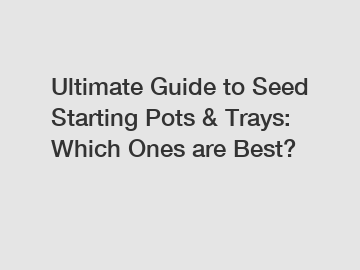Ultimate Guide to Seed Starting Pots & Trays: Which Ones are Best?
As spring approaches, gardeners everywhere are starting to think about planting seeds for the upcoming growing season. One of the key components to successful seed starting is choosing the right pots and trays to sow your seeds in. With so many options available on the market, it can be overwhelming to figure out which ones are best for your needs. In this ultimate guide to seed starting pots and trays, we will break down the different types of containers available and help you decide which ones are right for you.
Plastic Pots and Trays.
Plastic pots and trays are one of the most common options for starting seeds. They are lightweight, inexpensive, and reusable, making them a popular choice for many gardeners. Plastic pots come in a variety of sizes, from small cell trays to larger pots, making them versatile for different types of seeds. They also come with multiple drainage holes, which is essential for preventing waterlogged soil and promoting healthy root growth.

However, one downside to plastic pots and trays is that they can retain heat and moisture, which can lead to mold or fungal growth. To prevent this, make sure to water your seeds carefully and provide adequate air circulation. Additionally, some gardeners are concerned about the environmental impact of using plastic containers, as they are not biodegradable.
Peat Pots.
Peat pots are another popular choice for seed starting. These biodegradable pots are made from compressed peat moss and other organic materials, making them an eco-friendly option for gardeners looking to reduce their environmental impact. Peat pots can be planted directly into the soil, as they will break down over time and allow the roots to penetrate through the walls of the pot.
One advantage of peat pots is that they reduce transplant shock, as you can plant the entire pot into the ground without disturbing the roots. However, peat pots can be more expensive than plastic pots and trays, and they can dry out quickly if not watered regularly.
Cow Pots.
For gardeners looking for an even more eco-friendly option, cow pots are a great choice. Made from composted cow manure, these biodegradable pots are not only sustainable but also provide nutrients to your plants as they break down. Cow pots have a natural brown color and a slightly rough texture, which can help roots penetrate the walls of the pot.
One downside to cow pots is that they can be more expensive than other options, and they may not be as readily available at your local garden center. However, for environmentally-conscious gardeners, the benefits of using cow pots may outweigh the added cost.
Egg Cartons.
If you're looking for a budget-friendly and creative option for seed starting, consider using egg cartons. Not only are egg cartons biodegradable and readily available, but they also provide individual compartments for sowing seeds. Simply cut the lid off the carton, fill each cup with soil, and plant your seeds.
Egg cartons are best suited for seeds that don't require a lot of space for root growth, such as lettuce or herbs. Once your seedlings have outgrown the carton, you can easily tear off each cup and plant it directly into the soil. However, keep in mind that egg cartons can dry out quickly, so be sure to water your seeds regularly.
Seed Starting Trays.
In addition to individual pots, seed starting trays are another option for sowing seeds. These shallow trays typically have multiple compartments or cells, allowing you to plant several seeds in one container. Seed starting trays are convenient for starting multiple seeds at once and can help you save space on your windowsill or grow light setup.
Seed starting trays are available in both plastic and biodegradable options, making them a versatile choice for gardeners. Some trays also come with a clear plastic cover, which helps create a mini greenhouse effect and retains moisture for optimal germination. However, make sure to remove the cover once your seeds have sprouted to prevent mold or fungal growth.
In conclusion, the best seed starting pots and trays for you will depend on your personal preferences, budget, and environmental impact. Plastic pots and trays are versatile and affordable, peat pots are eco-friendly and reduce transplant shock, cow pots provide nutrients to your plants, egg cartons are budget-friendly and creative, and seed starting trays are convenient for starting multiple seeds at once. Whichever option you choose, be sure to provide your seeds with the proper care and attention they need to thrive. Happy planting!
If you want to learn more, please visit our website 15 Cells Garden Starter Trays, planting tray large, plastic growing trays supplier.
33
0
0

Comments
All Comments (0)